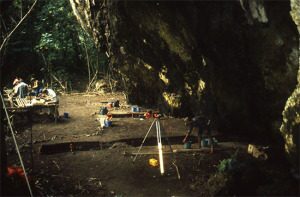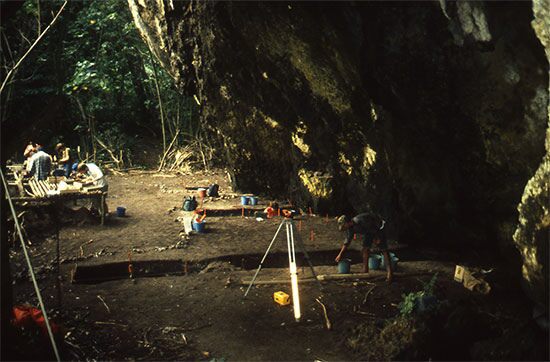
Chemical “fingerprints” tie prehistoric woodworking tools in the Southern Cook Islands to basalt extracted from quarries thousands of kilometers across the Pacific Ocean, according to a study. Excavations at the Tangatatau rockshelter on Mangaia Island in the Southern Cook Islands have yielded well-dated stratigraphic sequences spanning hundreds of years of human occupation. Artifacts within these sequences include a signature basalt adze known to be imported throughout Polynesia for more than 300 years beginning in the early AD 1300s. Marshall Weisler, Patrick Kirch, and colleagues used a technique to geochemically “fingerprint” 36 Tangatatau rockshelter artifacts related to adze making and to match the basalt to its geological source. According to the authors, some of the source material used to make the tools found its way to Mangaia across great distances, from quarries located in the Austral Islands, Tutuila in American Samoa, and the Marquesas archipelago, around 2,400 km to the east in French Polynesia. Furthermore, when placed in temporal context, the findings demonstrate an extensive voyaging network beyond the Cook Islands that lasted around 300 years into the early 1600s. The authors suggest that long-distance interactions among archipelagos continued to influence cultural development and social hierarchies in East Polynesia for more than a century after the region was first colonized.
The study was published as “Cook Island artifact geochemistry demonstrates spatial and temporal extent of pre-European interarchipelago voyaging in East Polynesia,” by Marshall I. Weisler et al., in the Proceedings of the National Academy of Sciences.
____________________________________________
Excavation in progress in 1991 at the Tangatatau Rockshelter, Mangaia Island. Image courtesy Patrick V. Kirch.
____________________________________________
 Illustration of basalt adze sections from the Tangatatau Rockshelter. Samples in the upper panel were geochemically sourced to Samoa. Image courtesy Patrick V. Kirch.
Illustration of basalt adze sections from the Tangatatau Rockshelter. Samples in the upper panel were geochemically sourced to Samoa. Image courtesy Patrick V. Kirch.
___________________________________________________________
Source: News release of the Proceedings of the National Academy of Sciences
___________________________________________________________

______________________________________________
Travel and learn with Far Horizons.
____________________________________________
This richly illustrated issue includes the following stories: Recent findings shedding new light on the whereabouts of the remains of Philip of Macedon, father of Alexander the Great; how an archaeologist-sculptor is bringing bones of the dead back to life; archaeologists uncovering town life at the dawn of civilization; an exclusive interview with internationally acclaimed archaeologist James M. Adovasio about what makes the Meadowcroft Rockshelter prominent in the ongoing search for the first Americans; what archaeologists are finding at the site of the ancient city of Gath, the home town of the biblical Philistine giant, Goliath; and how scientists are redrawing the picture of human evolution in Europe. Find it on Amazon.com.








